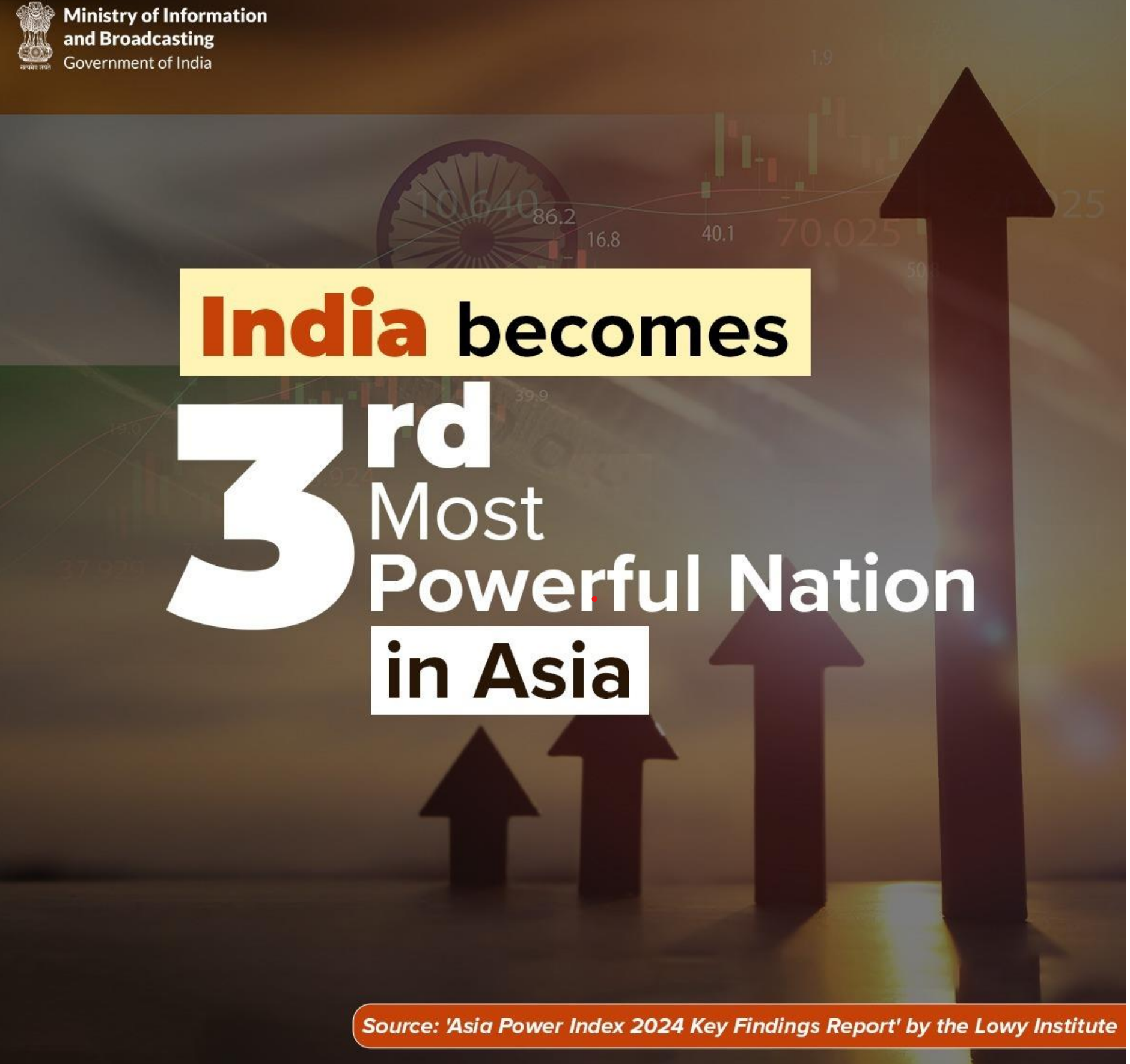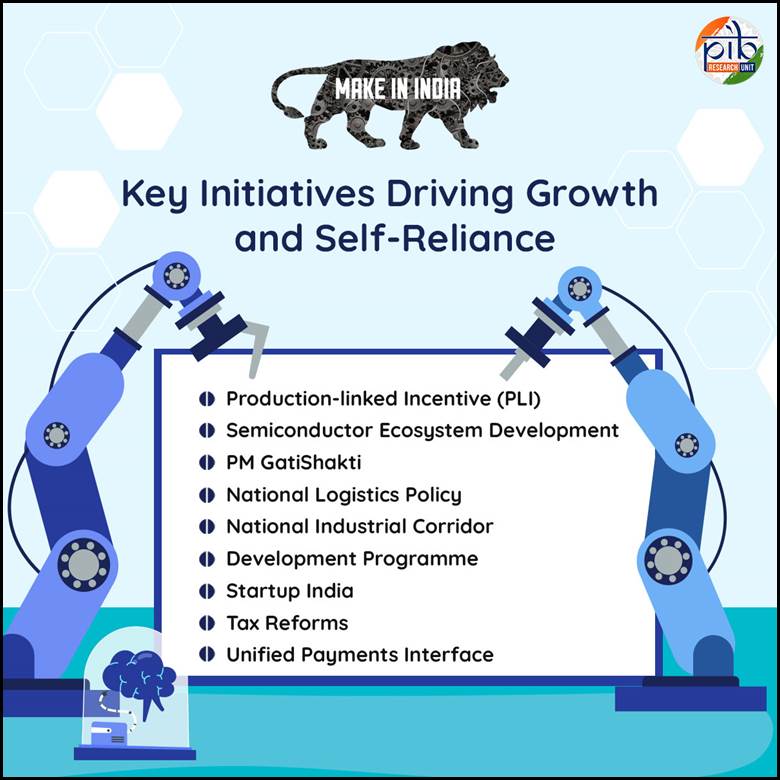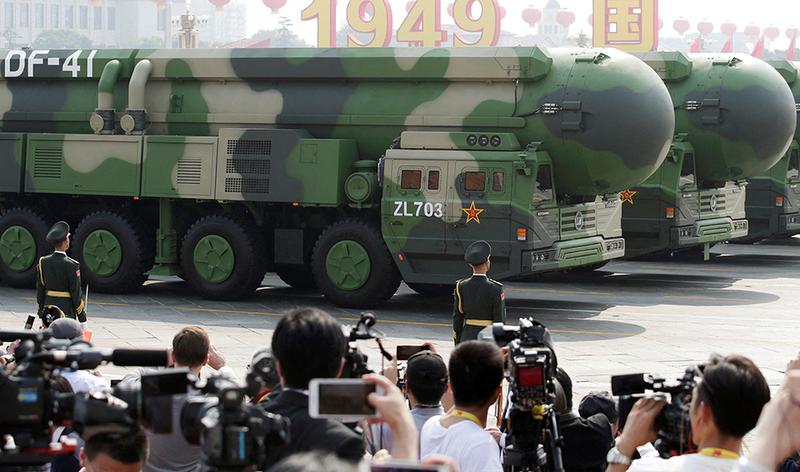ASIA POWER INDEX

- 26 Sep 2024
In News:
In a major shift, India surpassed Japan to become the third-largest power in the Asia Power Index, reflecting its increasing geopolitical stature. This achievement is driven by India's dynamic growth, youthful population, and expanding economy, solidifying its position as a leading force in the region.
Key Factors Behind India’s Rise:
- Economic Growth: India has shown remarkable post-pandemic economic recovery, contributing to a 4.2-point rise in its Economic Capability. India’s massive population and strong GDP growth reinforce its standing as the world’s third-largest economy in PPP terms.
- Future Potential: India’s Future Resources score increased by 8.2 points, signalling a potential demographic dividend. Unlike its regional competitors, particularly China and Japan, India benefits from a youthful population that will continue to drive economic growth and labour force expansion in the coming decades.
- Diplomatic Influence: Prime Minister Narendra Modi’s leadership has garnered greater international recognition. India’s non-aligned strategic posture has allowed New Delhi to navigate complex international waters effectively. India ranked 6th in terms of diplomatic dialogues in 2023, reflecting its active engagement in multilateral forums.
- Further, India’s large population and economic capabilities offer it substantial promise. India’s score in Cultural Influence has also remained relatively strong, underpinned by its global diaspora and cultural exports.
- In addition, India’s role in multilateral diplomacy and security cooperation has been a point of emphasis. India's participation in dialogues, as well as its leadership in the Quad, has allowed it to play a significant role in regional security dynamics, albeit outside of formal military alliances.
Asia Power Index
- The Asia Power Index, launched by the Lowy Institute in 2018, is an annual measure of power dynamics in the Asia-Pacific region.
- It evaluates 27 countries across the Asia-Pacific, examining their ability to shape and respond to the external environment.
- The 2024 edition offers one of the most comprehensive assessments of power distribution in the region to date. Timor-Leste has been included for the first time, reflecting its growing importance in Southeast Asia.
- The Index focuses on both the material capabilities of states and the influence they exert on the international stage.
Criteria and Parameters of Power Measurement
Power in the Asia Power Index is divided into resource-based and influence-based determinants:
- Resource-Based Determinants:
- Economic Capability: The core economic strength of a country, measured through indicators like GDP at purchasing power parity (PPP), technological sophistication, and global economic connectivity.
- Military Capability: Evaluates conventional military strength based on defense spending, armed forces, weapon systems, and signature capabilities like long-range power projection.
- Resilience: The internal capacity to deter threats to state stability, including institutional robustness, geopolitical security, and resource security.
- Future Resources: Forecasts the future distribution of resources, including economic, military, and demographic factors projected for 2035.
- Influence-Based Determinants:
- Economic Relationships: The capacity to exercise leverage through trade, investment, and economic diplomacy.
- Defense Networks: The strength of alliances and partnerships, measured through military cooperation and arms transfers.
- Diplomatic Influence: The extent of a country's diplomatic reach, participation in multilateral forums, and foreign policy ambition.
- Cultural Influence: The ability to shape international public opinion through cultural exports, media, and people-to-people ties.
A country's overall power score is derived from a weighted average of these eight measures, encompassing 131 individual indicators. The results offer a nuanced understanding of how countries convert their resources into influence within the Asia-Pacific.
10 YEARS OF MAKE IN INDIA

- 26 Sep 2024
In News:
The “Make in India” initiative has completed 10 years. It was launched by Prime Minister Narendra Modi on September 25, 2014.
KEY TAKEAWAYS:
- The ‘Make in India’ campaign aims to facilitate investment, foster innovation, enhance skill development, protect intellectual property & build best in class manufacturing infrastructure.
- “Make in India” was designed to transform India into a global hub for design and manufacturing.
- Seen as an important ‘Vocal for Local’ initiative, its objective is twofold. Firstly, to boost India’s manufacturing capabilities and secondly to showcase its industrial potential on a global stage.
- The “Make in India 2.0” phase encompassing 27 sectors – both manufacturing and service.
4 pillars of “Make in India” initiative:
- New Processes: To enhance the business environment, promote entrepreneurship and startups – ‘ease of doing business’ became a crucial factor.
- New Infrastructure: Development of industrial corridors, smart cities, integrating state-of-the-art technology and high-speed communication to create world-class infrastructure, improving intellectual property rights (IPR) infrastructure etc.
- New Sectors: Opening of Foreign Direct Investment (FDI) in sectors like Defence Production, Insurance, Medical Devices, Construction, and Railway infrastructure.
- New Mindset: In order to support industrial growth and innovation – the government embraced a role as a facilitator rather than a regulator. The Government partners with industry in the economic development of the country.
Key Initiatives to enable Make in India initiative
Production linked Incentive (PLI) Schemes: The primary goals of the PLI Schemes are to attract substantial investments, incorporate advanced technology, and ensure operational efficiency. These schemes cover 14 key sectors aimed at fostering investment in cutting-edge technology and promoting global competitiveness.
PM GatiShakti: It is a strategic initiative aimed at achieving Aatmanirbhar Bharat and a US $5 trillion economy by 2025 through the creation of multimodal and last-mile connectivity infrastructure. PM GatiShakti is a transformative approach for economic growth and sustainable development. The approach is driven by 7 engines, namely:
- Railways
- Roads
- Ports
- Waterways
- Airports
- Mass Transport
- Logistics Infrastructure
Semiconductor Ecosystem Development: It encompasses four key schemes:
- Modified Scheme for Setting Up Semiconductor Fabs in India
- Modified Scheme for Setting Up Display Fabs in India
- Modified Scheme for Setting Up Compound Semiconductors, Silicon Photonics, Sensors Fabs, and Discrete Semiconductors, along with Semiconductor Assembly, Testing, Marking, and Packaging (ATMP) / OSAT Facilities in India
- Design Linked Incentive (DLI) Scheme
It aims to foster the development of a sustainable semiconductor and display ecosystem in the country.
The Semicon India Programme aims to provide a significant impetus to semiconductor and display manufacturing by facilitating capital support and promoting technological collaborations.
National Logistics Policy: Introduced to complement the PM GatiShakti National Master Plan. It focusses on enhancing the soft infrastructure of India’s logistics sector.
The Comprehensive Logistics Action Plan (CLAP) was rolled out. The key areas which it addresses are logistics systems, standardization, human resource development, state engagement, and logistics parks.
The National Industrial Corridor Development Programme: Aims to create “Smart Cities” and advanced industrial hubs.
Startup India: Several programs aimed at supporting entrepreneurs, building a robust startup ecosystem, and transforming India into a country of job creators instead of job seekers were rolled out.
Implementation of the Goods and Services Tax (GST): As India’s tax reforms, it is seen as crucial in the context of the Make in India initiative.
Unified Payments Interface: For India’s digital economy growth, it is seen as one of the key initiatives to enable ease of doing business.
Ease of Doing Business: The efforts aim to simplify regulations, reduce bureaucratic hurdles, and create a more business-friendly environment, significantly boosting investor confidence and supporting the objectives of the Make in India initiative.
China test-fires an intercontinental ballistic missile into the Pacific Ocean

- 26 Sep 2024
In News:
China stated that it test-launched an intercontinental ballistic missile, firing it into the Pacific Ocean in its first such exercise in decades.
- Launch Details:
- The missile carried a dummy warhead and fell into a designated area in the high seas.
- The specific flight path and landing location were not disclosed.
- Testing Objectives:
- The launch tested weapon performance and troop training levels, achieving its expected objectives.
- Historical Context:
- This is the first ICBM test over the Pacific Ocean in over 40 years.
- China's first ICBM, the DF-5, was test-fired in 1980.
- ICBM Specifications:
- The latest ICBM, likely the DF-41, has an estimated range of 12,000 to 15,000 kilometers (7,400 to 9,300 miles), capable of reaching the US mainland.
- Strategic Messaging:
- Analysts interpret the test as a warning to the US, suggesting direct intervention in Taiwan could expose the American homeland.
- The test signals China's ability to engage multiple fronts simultaneously.
- Regional Tensions:
- Recent weeks have seen heightened tensions with Japan, the Philippines, and Taiwan due to military incursions and exercises.
- International Norms:
- There is a global expectation to notify nations of long-range missile launches to avoid miscalculations. China has limited agreements regarding this, primarily with Russia.
- Military Buildup:
- Under Xi Jinping, China has enhanced its nuclear capabilities and revamped the PLA’s Rocket Force.
- Recent satellite imagery indicates the construction of hundreds of ICBM silos in China’s deserts.
- Future Projections:
- As of 2023, China has over 500 operational nuclear warheads, projected to exceed 1,000 by 2030 according to the Pentagon.
- Implications of the Test:
- The ICBM test may be aimed at demonstrating military readiness despite recent corruption scandals within the Rocket Force.
About ICBMs:
- An intercontinental ballistic missile (ICBM) is a long-range ballistic missile system primarily designed for nuclear weapons delivery. They are powerful and destructive weapons, capable of travelling vast distances at incredibly high speeds.
- Key features of ICBMs:
- Range: Range greater than 5,500 kilometres with maximum ranges varying from 7,000 to 16,000 kilometres.
- Speed: ICBMs can travel at speeds exceeding 20,000 kilometres per hour.
- Payload: Typically designed to carry nuclear warheads, though they could potentially be used to deliver other types of weapons, such as chemical or biological weapons.
- Deployment: ICBMs can be launched from silos underground, mobile launchers on land, or submarines at sea.
- Countries having operational ICBMs: Russia, United States, China, France, India, United Kingdom, Israel and North Korea.
INDIA'S BIOE3 POLICY AND SMART PROTEINS

- 26 Sep 2024
In News:
The Indian government recently approved the Biotechnology for Economy, Environment, and Employment (Bioe3) Policy, which prioritizes the production of "smart proteins". This initiative aligns with broader national goals of achieving a sustainable, circular bioeconomy and a Net Zero carbon economy.
What Are Smart Proteins?
Smart proteins are alternative proteins derived from unconventional sources such as:
- Algae
- Fungi
- Insects
- Fermentation processes
- Lab-grown cells
This category also includes plant-based proteins, designed to replicate the taste and nutritional value of animal products without the need for livestock farming.
Environmental Benefits
The production of smart proteins offers significant environmental advantages:
- Water Use: 72-99% less water compared to conventional meat.
- Land Use: 47-99% less land required.
- Water Pollution: 51-91% reduction in pollution.
- Greenhouse Gas Emissions: 30-90% fewer emissions.
Health and Safety
With rising incomes, India's protein consumption has increased, from 9.7% of calories in 1991 to 11% in 2021. Smart proteins:
- Enhance food safety by reducing the risk of zoonotic diseases.
- Foster ethical consumption and align with traditional Indian dietary preferences.
Objectives of the BioE3 Policy
The Bioe3 Policy aims to:
- Foster high-performance biomanufacturing.
- Promote sustainable growth and innovation in biotechnology.
- Support the transition towards a Net Zero carbon economy.
By emphasizing the development of smart proteins, the Bioe3 Policy represents a strategic move towards a more sustainable and resilient food system in India.
ACHIEVING GLOBAL NUCLEAR DISARMAMENT

- 26 Sep 2024
Overview
Global nuclear disarmament remains a top priority for the United Nations, initially emphasized in the General Assembly’s first resolution in 1946. Despite historical efforts, approximately 12,100 nuclear weapons still exist today, with ongoing modernization plans in many countries.
Key Historical Milestones
- 1945: Atomic bombings of Hiroshima and Nagasaki, killing an estimated 213,000 people.
- 1946: First UN resolution identifies nuclear disarmament as a key goal.
- 1959: General Assembly endorses the goal of general and complete disarmament.
- 1963: Opening of the Partial Test Ban Treaty.
- 1978: First Special Session of the General Assembly dedicated to disarmament.
- 1996: Comprehensive Nuclear-Test-Ban Treaty opens for signature.
- 2017: Adoption of the Treaty on the Prohibition of Nuclear Weapons.
Recent Developments
- 2019: U.S. withdrawal from the Intermediate-Range Nuclear Forces Treaty.
- 2023: Russia suspends participation in the New START Treaty, raising concerns over arms control.
The International Day for the Total Elimination of Nuclear Weapons
- Established: December 2013, following a high-level meeting on nuclear disarmament.
- Observed: Annually on September 26.
- Purpose: Raise awareness about the dangers of nuclear weapons and promote their total elimination.
Goals of the International Day
- Enhance public education on the humanitarian risks associated with nuclear weapons.
- Mobilize international efforts towards a nuclear-weapon-free world.
Continuing Challenges
- The doctrine of nuclear deterrence remains central to the security policies of nuclear-armed states and their allies.
- No nuclear weapons have been destroyed under a treaty framework, and current disarmament negotiations are stagnant.
- Growing frustration among UN Member States over the slow progress in nuclear disarmament.
